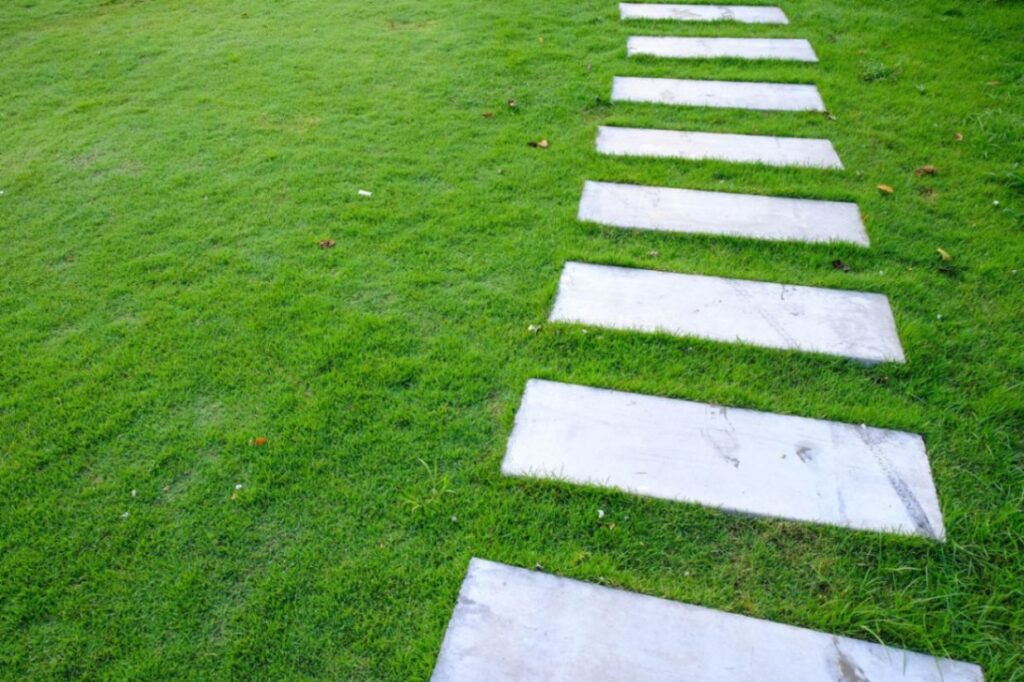When getting your landscape ready for concrete work, the little details matter. You need to carefully assess your site, paying close attention to the existing plants and soil conditions. Protecting nearby plants is important, and it’s also essential to make sure the soil has the right moisture levels. Once the concrete is in place, taking care of the surrounding landscape is just as crucial. How you manage these aspects will affect the overall success of your project and the look of your outdoor space. What will you focus on first?

Key Takeaways
- Conduct a thorough landscape assessment to check soil composition, vegetation, and drainage. This will help guide the best methods for preparing the area for concrete.
- Protect existing plants with barriers, water them well, and relocate vulnerable species to avoid stress during construction.
- Choose the right concrete mix based on load-bearing needs and environmental factors to ensure durability and functionality.
- Keep the concrete moist during curing for at least a week, and watch over your plants to help them recover.
- Implement a regular maintenance routine to keep the landscape looking great, including mulching and checking for drainage problems.
Assessing Your Landscape Needs
Before jumping into concrete work, it’s important to understand what your landscape really needs. Start by doing a thorough landscape assessment.
Walk through your outdoor space, noting any areas that need improvement, like uneven surfaces or drainage problems. Pay attention to the plants and how they might interact with your new concrete features.
Next, test the soil to understand its stability and composition. Dig a small hole to check if the soil absorbs water properly. Healthy soil should drain well.
This information will guide you in choosing the best location and preparation methods for your concrete. By taking the time to assess your landscape, you’ll ensure it can handle the new features and enhance both its function and appearance.
Choosing the Right Concrete Type
Selecting the right concrete mix is important for the success of your project. Each mix has unique properties that affect its strength and durability. Understanding these different mixes will help you match the concrete to your specific needs.
Think about things like how much weight the concrete will bear and the environmental conditions. These factors are crucial to making sure your landscape is both strong and long-lasting.
Types of Concrete Mixes
When choosing the right concrete mix, keep in mind that there are several types, including standard, high-strength, and decorative mixes. Each one has different mixing techniques that affect its texture and finish. For example, decorative mixes may include colored pigments or aggregates to improve the look.
You might also consider additives like superplasticizers for easier workability or air-entraining agents to help the concrete resist freeze-thaw damage. Knowing these options allows you to pick the right mix for your specific needs, making sure your landscape not only lasts but also looks great.
Durability and Strength Factors
When selecting concrete, it’s also important to think about durability and strength. High-strength concrete improves the integrity of your landscape, ensuring that things like pathways and patios can handle heavy traffic and weather changes.
Look for concrete with additives that help prevent cracking and wear. This will increase its lifespan. Factors like compressive strength and freeze-thaw resistance are important to ensure the concrete stays strong for years.
Choosing a durable, high-quality concrete mix will not only improve the look of your landscape but will also create a solid foundation that stands the test of time.
Planning the Layout and Design
Before starting concrete installation, take time to assess the site conditions and plan the layout of your landscape.
Assess Site Conditions
Start with a site evaluation. Look for features like trees, slopes, and existing drainage patterns that could affect your concrete. This step will help you avoid potential problems and identify opportunities.
Conduct soil testing to check the stability of the ground. Poor soil conditions can lead to cracking or settling, so it’s important not to skip this step.
Define Functional Areas
Once you understand the site conditions, you can define functional areas in your landscape. Think about what you want to use the space for—entertainment, gardening, or pathways—and plan accordingly. A well-planned layout will make the best use of your space.
For example, position seating areas near gardens for a relaxing view while ensuring easy maintenance. Plan pathways carefully so that they allow smooth movement without being too narrow. Use hardscaping features like patios or retaining walls to define zones and create a more organized layout.
Protecting Existing Plants and Soil
While preparing for concrete work, it’s essential to protect your plants and soil. Healthy plants are a key part of a beautiful garden, so their well-being should be a top priority.
Start by evaluating the proximity of plants to the work area. Cover them with burlap or canvas to shield them from dust and debris. For delicate plants, consider installing temporary barriers for extra protection.
Water your plants thoroughly before starting the project to minimize stress on the roots. If possible, relocate vulnerable plants to a safer spot until the work is done.
Finally, cover the soil with mulch to keep moisture in and prevent soil compaction. Taking these steps will help your garden thrive during the concrete installation.
Preparing the Site for Concrete Installation
Before beginning the concrete installation, ensure that the site is ready. Proper preparation will help prevent issues later.
Start by checking the drainage. Water pooling can weaken the concrete over time, so make sure the ground slopes away from buildings and other structures to allow water to run off properly.
Next, check the soil compaction. Loose soil can cause the concrete to settle or crack. Use a plate compactor or roller to compact the soil, creating a solid base for the concrete.
Finally, remove any debris, weeds, or vegetation to create a clean workspace for installation.
Caring for Your Landscape During Concrete Work
Once the site is prepped, consider how the installation process will affect your surrounding landscape. During construction, take steps to protect your plants and soil.
Use temporary barriers like plywood or fencing around sensitive areas to shield them from foot traffic and equipment damage. Keep these barriers in place as needed to prevent any damage to your plants or soil.
Cover any exposed soil to protect it from erosion and contamination with debris. Keep an eye on the work area and adjust the barriers if needed.
Post-Installation Maintenance Tips
After the concrete work is done, proper maintenance will ensure that both your concrete features and plants thrive. Start by curing the concrete properly, keeping it moist for at least a week to prevent cracks.
Implement a regular cleaning routine to remove debris and stains from your concrete surfaces, keeping them looking fresh.
For your plants, watch for signs of recovery, making sure they get enough water and nutrients as they adjust to the changes.
Mulching can help retain moisture and regulate the soil temperature, aiding the recovery of both plants and soil.
Finally, check for any drainage problems. Addressing these issues early will help keep both your concrete and plants in good condition.
Enhancing the Transition Between Hardscaping and Greenery
To create a smooth transition between hardscaping and greenery, consider using a variety of materials and design elements. Edging materials like stone or metal can help define the borders between concrete and plant areas, improving integration.
Incorporate plants with different heights and textures to make the transition look natural. For example, low-maintenance ground covers can soften concrete edges, while taller plants can add visual interest.
Use colors from both your hardscape and plants to tie everything together. Decorative elements like gravel or mulch can help create a seamless flow, making your hardscaping feel more inviting and connected to the greenery.
These thoughtful design choices will help create a balanced, harmonious outdoor space.
Frequently Asked Questions
How Long Should I Wait Before Planting After Concrete Installation?
Wait at least 28 days before planting. This allows the concrete to cure properly, giving your plants the best chance to thrive.
Can I Install Irrigation Systems Before Concrete Work Begins?
Yes! Installing irrigation systems before concrete work is a good idea. This ensures that pipes and components are placed correctly, without disrupting the concrete installation.
What Should I Do if My Plants Are Damaged During Installation?
If plants are damaged, assess the damage right away. Trim any dead parts and give your plants plenty of water and nutrients to help them recover.
Are There Specific Times of Year Better for Concrete Work?
Yes, spring and fall are ideal times for concrete work. Mild temperatures help with curing and reduce the risk of cracks.
How Can I Prevent Weeds From Growing in Concrete Joints?
Regular maintenance and joint sealing can help prevent weeds in concrete joints. Using a high-quality sealant will keep your surface clean and weed-free.
Conclusion
In conclusion, preparing your landscape for concrete work—and caring for it afterward—plays a big role in the success of your project. By evaluating your needs, choosing the right materials, and protecting your plants, you can create a beautiful, functional outdoor space. Take time for proper maintenance, and you’ll enjoy a landscape that stays vibrant and durable for years.
